IMI Strategic Management: Competitive Advantage & Market Leadership
VerifiedAdded on 2023/06/17
|9
|2555
|265
Report
AI Summary
This report provides a detailed analysis of IMI, a global engineering group, focusing on its strategic management approaches. It evaluates the purpose of IMI's business strategy, particularly how managing knowledge and skills contributes to its competitive advantage. The report assesses the implementation of IMI's niche market strategy in light of its competitive advantages and the external environment, using the SLEPT framework to analyze social, legal, environmental, political, and technological factors. Furthermore, it recommends three strategic choices for differentiating IMI's business within the global market to achieve and sustain long-term market leadership objectives, emphasizing service differentiation, product innovation, and price differentiation. The analysis concludes that by combining knowledge, skills, and market insights, IMI can develop innovative solutions, create a competitive advantage, and responsibly serve its customers in niche markets worldwide.
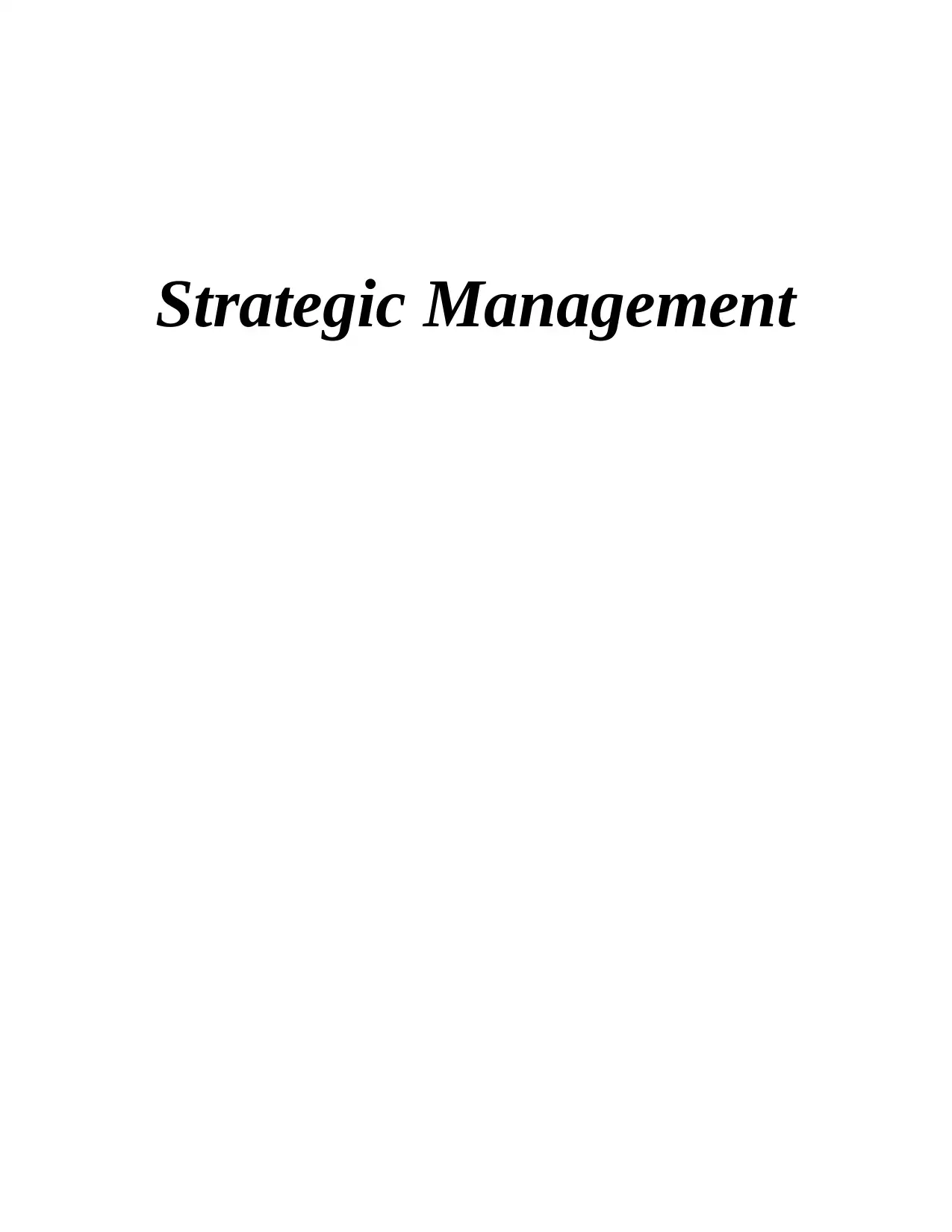
Strategic Management
Paraphrase This Document
Need a fresh take? Get an instant paraphrase of this document with our AI Paraphraser
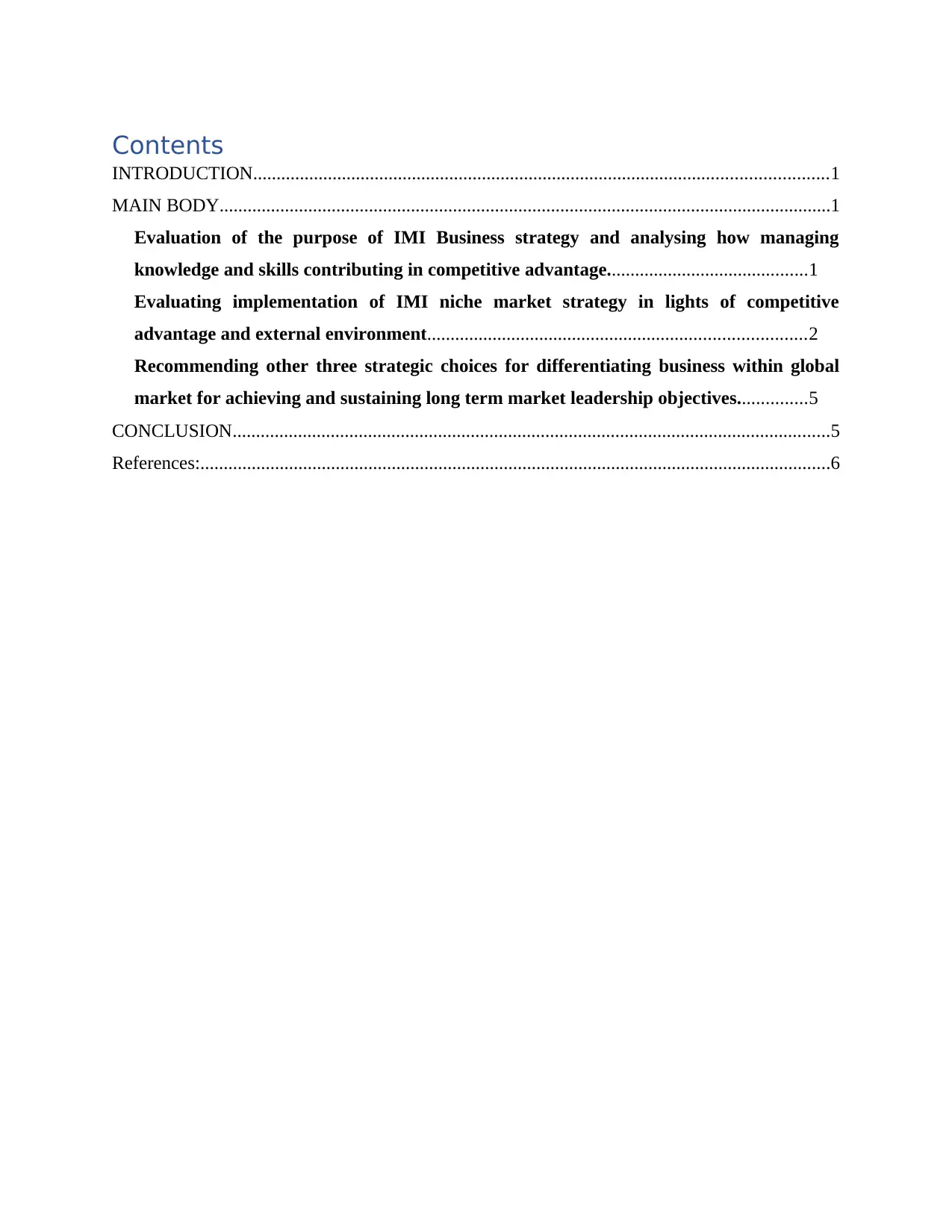
Contents
INTRODUCTION...........................................................................................................................1
MAIN BODY...................................................................................................................................1
Evaluation of the purpose of IMI Business strategy and analysing how managing
knowledge and skills contributing in competitive advantage...........................................1
Evaluating implementation of IMI niche market strategy in lights of competitive
advantage and external environment.................................................................................2
Recommending other three strategic choices for differentiating business within global
market for achieving and sustaining long term market leadership objectives...............5
CONCLUSION................................................................................................................................5
References:.......................................................................................................................................6
INTRODUCTION...........................................................................................................................1
MAIN BODY...................................................................................................................................1
Evaluation of the purpose of IMI Business strategy and analysing how managing
knowledge and skills contributing in competitive advantage...........................................1
Evaluating implementation of IMI niche market strategy in lights of competitive
advantage and external environment.................................................................................2
Recommending other three strategic choices for differentiating business within global
market for achieving and sustaining long term market leadership objectives...............5
CONCLUSION................................................................................................................................5
References:.......................................................................................................................................6
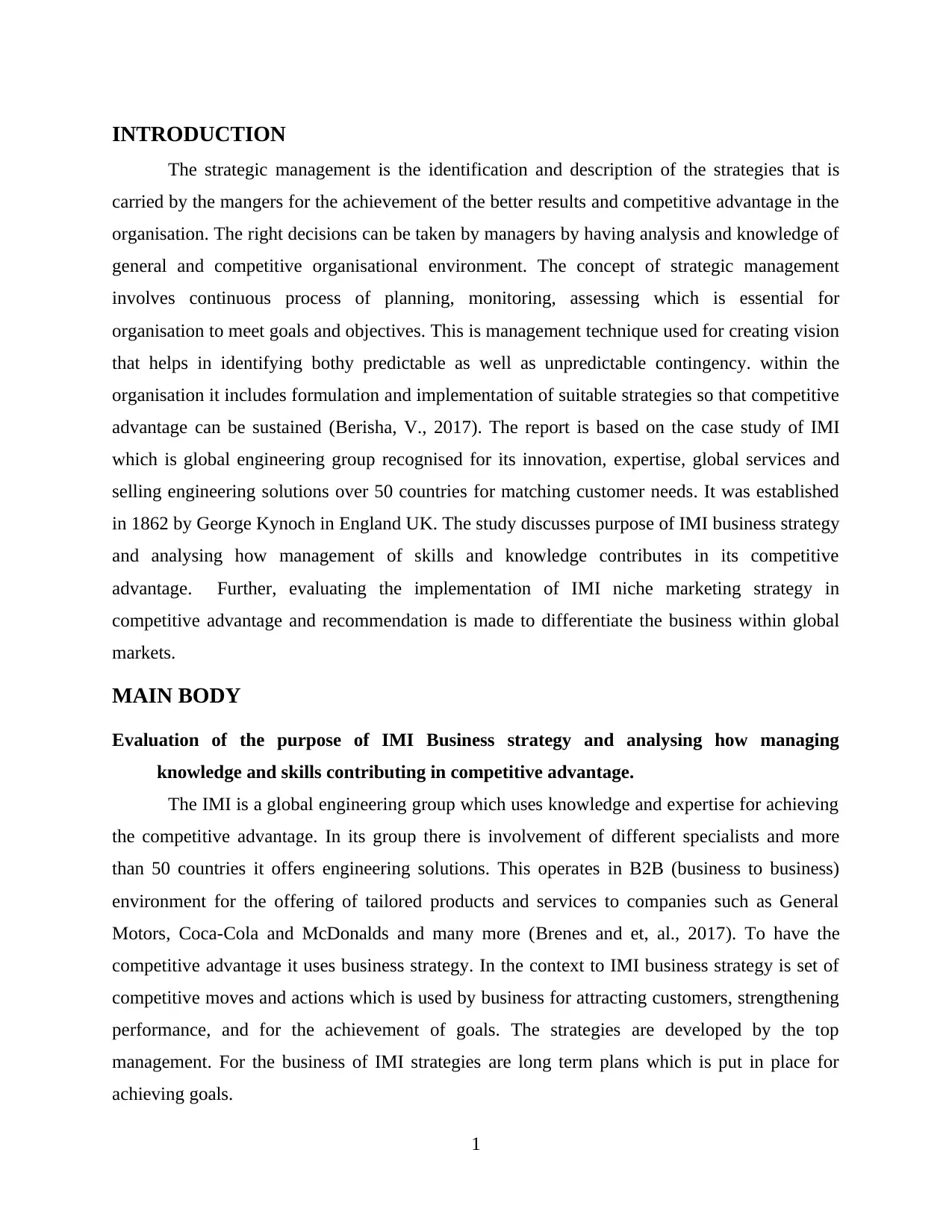
INTRODUCTION
The strategic management is the identification and description of the strategies that is
carried by the mangers for the achievement of the better results and competitive advantage in the
organisation. The right decisions can be taken by managers by having analysis and knowledge of
general and competitive organisational environment. The concept of strategic management
involves continuous process of planning, monitoring, assessing which is essential for
organisation to meet goals and objectives. This is management technique used for creating vision
that helps in identifying bothy predictable as well as unpredictable contingency. within the
organisation it includes formulation and implementation of suitable strategies so that competitive
advantage can be sustained (Berisha, V., 2017). The report is based on the case study of IMI
which is global engineering group recognised for its innovation, expertise, global services and
selling engineering solutions over 50 countries for matching customer needs. It was established
in 1862 by George Kynoch in England UK. The study discusses purpose of IMI business strategy
and analysing how management of skills and knowledge contributes in its competitive
advantage. Further, evaluating the implementation of IMI niche marketing strategy in
competitive advantage and recommendation is made to differentiate the business within global
markets.
MAIN BODY
Evaluation of the purpose of IMI Business strategy and analysing how managing
knowledge and skills contributing in competitive advantage.
The IMI is a global engineering group which uses knowledge and expertise for achieving
the competitive advantage. In its group there is involvement of different specialists and more
than 50 countries it offers engineering solutions. This operates in B2B (business to business)
environment for the offering of tailored products and services to companies such as General
Motors, Coca-Cola and McDonalds and many more (Brenes and et, al., 2017). To have the
competitive advantage it uses business strategy. In the context to IMI business strategy is set of
competitive moves and actions which is used by business for attracting customers, strengthening
performance, and for the achievement of goals. The strategies are developed by the top
management. For the business of IMI strategies are long term plans which is put in place for
achieving goals.
1
The strategic management is the identification and description of the strategies that is
carried by the mangers for the achievement of the better results and competitive advantage in the
organisation. The right decisions can be taken by managers by having analysis and knowledge of
general and competitive organisational environment. The concept of strategic management
involves continuous process of planning, monitoring, assessing which is essential for
organisation to meet goals and objectives. This is management technique used for creating vision
that helps in identifying bothy predictable as well as unpredictable contingency. within the
organisation it includes formulation and implementation of suitable strategies so that competitive
advantage can be sustained (Berisha, V., 2017). The report is based on the case study of IMI
which is global engineering group recognised for its innovation, expertise, global services and
selling engineering solutions over 50 countries for matching customer needs. It was established
in 1862 by George Kynoch in England UK. The study discusses purpose of IMI business strategy
and analysing how management of skills and knowledge contributes in its competitive
advantage. Further, evaluating the implementation of IMI niche marketing strategy in
competitive advantage and recommendation is made to differentiate the business within global
markets.
MAIN BODY
Evaluation of the purpose of IMI Business strategy and analysing how managing
knowledge and skills contributing in competitive advantage.
The IMI is a global engineering group which uses knowledge and expertise for achieving
the competitive advantage. In its group there is involvement of different specialists and more
than 50 countries it offers engineering solutions. This operates in B2B (business to business)
environment for the offering of tailored products and services to companies such as General
Motors, Coca-Cola and McDonalds and many more (Brenes and et, al., 2017). To have the
competitive advantage it uses business strategy. In the context to IMI business strategy is set of
competitive moves and actions which is used by business for attracting customers, strengthening
performance, and for the achievement of goals. The strategies are developed by the top
management. For the business of IMI strategies are long term plans which is put in place for
achieving goals.
1
⊘ This is a preview!⊘
Do you want full access?
Subscribe today to unlock all pages.

Trusted by 1+ million students worldwide
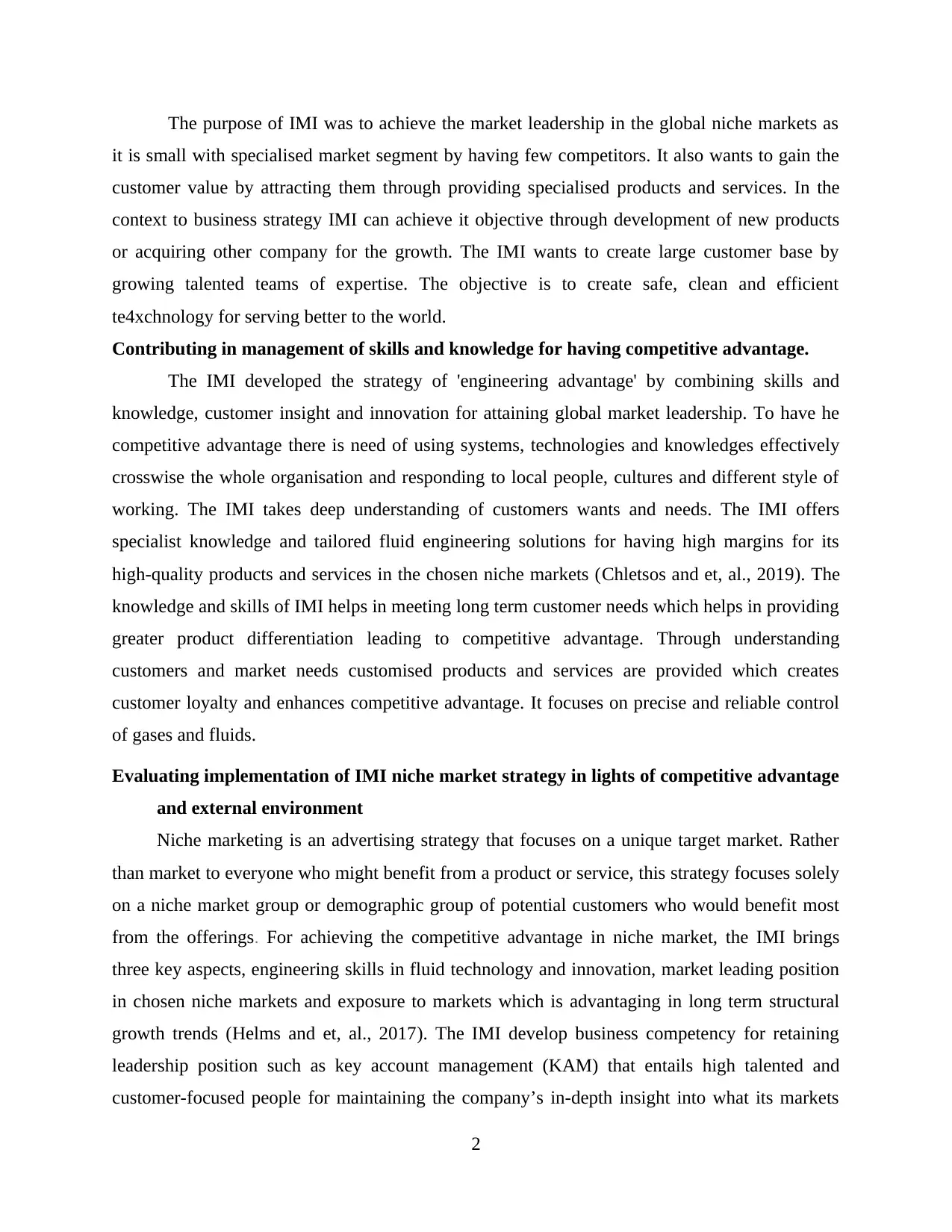
The purpose of IMI was to achieve the market leadership in the global niche markets as
it is small with specialised market segment by having few competitors. It also wants to gain the
customer value by attracting them through providing specialised products and services. In the
context to business strategy IMI can achieve it objective through development of new products
or acquiring other company for the growth. The IMI wants to create large customer base by
growing talented teams of expertise. The objective is to create safe, clean and efficient
te4xchnology for serving better to the world.
Contributing in management of skills and knowledge for having competitive advantage.
The IMI developed the strategy of 'engineering advantage' by combining skills and
knowledge, customer insight and innovation for attaining global market leadership. To have he
competitive advantage there is need of using systems, technologies and knowledges effectively
crosswise the whole organisation and responding to local people, cultures and different style of
working. The IMI takes deep understanding of customers wants and needs. The IMI offers
specialist knowledge and tailored fluid engineering solutions for having high margins for its
high-quality products and services in the chosen niche markets (Chletsos and et, al., 2019). The
knowledge and skills of IMI helps in meeting long term customer needs which helps in providing
greater product differentiation leading to competitive advantage. Through understanding
customers and market needs customised products and services are provided which creates
customer loyalty and enhances competitive advantage. It focuses on precise and reliable control
of gases and fluids.
Evaluating implementation of IMI niche market strategy in lights of competitive advantage
and external environment
Niche marketing is an advertising strategy that focuses on a unique target market. Rather
than market to everyone who might benefit from a product or service, this strategy focuses solely
on a niche market group or demographic group of potential customers who would benefit most
from the offerings. For achieving the competitive advantage in niche market, the IMI brings
three key aspects, engineering skills in fluid technology and innovation, market leading position
in chosen niche markets and exposure to markets which is advantaging in long term structural
growth trends (Helms and et, al., 2017). The IMI develop business competency for retaining
leadership position such as key account management (KAM) that entails high talented and
customer-focused people for maintaining the company’s in-depth insight into what its markets
2
it is small with specialised market segment by having few competitors. It also wants to gain the
customer value by attracting them through providing specialised products and services. In the
context to business strategy IMI can achieve it objective through development of new products
or acquiring other company for the growth. The IMI wants to create large customer base by
growing talented teams of expertise. The objective is to create safe, clean and efficient
te4xchnology for serving better to the world.
Contributing in management of skills and knowledge for having competitive advantage.
The IMI developed the strategy of 'engineering advantage' by combining skills and
knowledge, customer insight and innovation for attaining global market leadership. To have he
competitive advantage there is need of using systems, technologies and knowledges effectively
crosswise the whole organisation and responding to local people, cultures and different style of
working. The IMI takes deep understanding of customers wants and needs. The IMI offers
specialist knowledge and tailored fluid engineering solutions for having high margins for its
high-quality products and services in the chosen niche markets (Chletsos and et, al., 2019). The
knowledge and skills of IMI helps in meeting long term customer needs which helps in providing
greater product differentiation leading to competitive advantage. Through understanding
customers and market needs customised products and services are provided which creates
customer loyalty and enhances competitive advantage. It focuses on precise and reliable control
of gases and fluids.
Evaluating implementation of IMI niche market strategy in lights of competitive advantage
and external environment
Niche marketing is an advertising strategy that focuses on a unique target market. Rather
than market to everyone who might benefit from a product or service, this strategy focuses solely
on a niche market group or demographic group of potential customers who would benefit most
from the offerings. For achieving the competitive advantage in niche market, the IMI brings
three key aspects, engineering skills in fluid technology and innovation, market leading position
in chosen niche markets and exposure to markets which is advantaging in long term structural
growth trends (Helms and et, al., 2017). The IMI develop business competency for retaining
leadership position such as key account management (KAM) that entails high talented and
customer-focused people for maintaining the company’s in-depth insight into what its markets
2
Paraphrase This Document
Need a fresh take? Get an instant paraphrase of this document with our AI Paraphraser
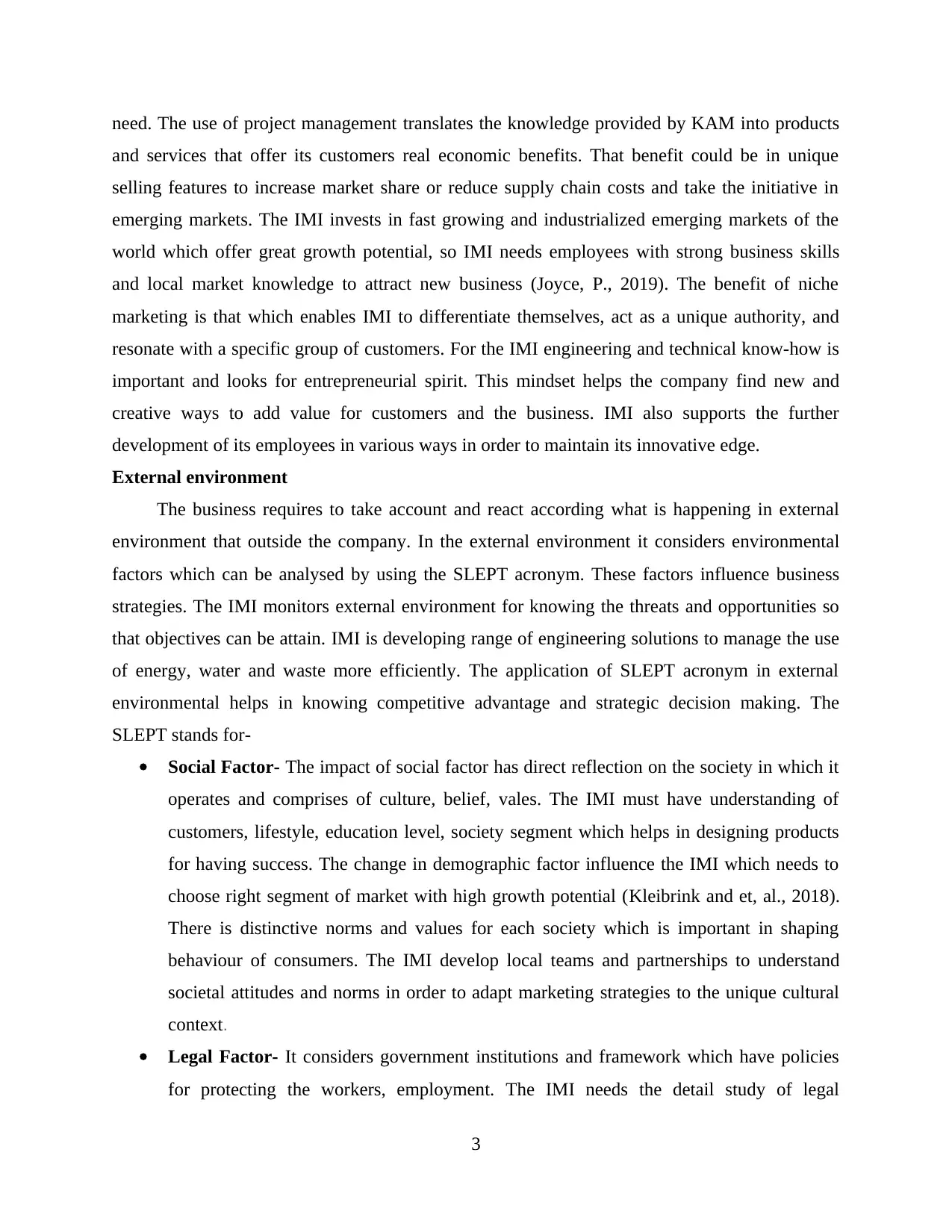
need. The use of project management translates the knowledge provided by KAM into products
and services that offer its customers real economic benefits. That benefit could be in unique
selling features to increase market share or reduce supply chain costs and take the initiative in
emerging markets. The IMI invests in fast growing and industrialized emerging markets of the
world which offer great growth potential, so IMI needs employees with strong business skills
and local market knowledge to attract new business (Joyce, P., 2019). The benefit of niche
marketing is that which enables IMI to differentiate themselves, act as a unique authority, and
resonate with a specific group of customers. For the IMI engineering and technical know-how is
important and looks for entrepreneurial spirit. This mindset helps the company find new and
creative ways to add value for customers and the business. IMI also supports the further
development of its employees in various ways in order to maintain its innovative edge.
External environment
The business requires to take account and react according what is happening in external
environment that outside the company. In the external environment it considers environmental
factors which can be analysed by using the SLEPT acronym. These factors influence business
strategies. The IMI monitors external environment for knowing the threats and opportunities so
that objectives can be attain. IMI is developing range of engineering solutions to manage the use
of energy, water and waste more efficiently. The application of SLEPT acronym in external
environmental helps in knowing competitive advantage and strategic decision making. The
SLEPT stands for-
Social Factor- The impact of social factor has direct reflection on the society in which it
operates and comprises of culture, belief, vales. The IMI must have understanding of
customers, lifestyle, education level, society segment which helps in designing products
for having success. The change in demographic factor influence the IMI which needs to
choose right segment of market with high growth potential (Kleibrink and et, al., 2018).
There is distinctive norms and values for each society which is important in shaping
behaviour of consumers. The IMI develop local teams and partnerships to understand
societal attitudes and norms in order to adapt marketing strategies to the unique cultural
context.
Legal Factor- It considers government institutions and framework which have policies
for protecting the workers, employment. The IMI needs the detail study of legal
3
and services that offer its customers real economic benefits. That benefit could be in unique
selling features to increase market share or reduce supply chain costs and take the initiative in
emerging markets. The IMI invests in fast growing and industrialized emerging markets of the
world which offer great growth potential, so IMI needs employees with strong business skills
and local market knowledge to attract new business (Joyce, P., 2019). The benefit of niche
marketing is that which enables IMI to differentiate themselves, act as a unique authority, and
resonate with a specific group of customers. For the IMI engineering and technical know-how is
important and looks for entrepreneurial spirit. This mindset helps the company find new and
creative ways to add value for customers and the business. IMI also supports the further
development of its employees in various ways in order to maintain its innovative edge.
External environment
The business requires to take account and react according what is happening in external
environment that outside the company. In the external environment it considers environmental
factors which can be analysed by using the SLEPT acronym. These factors influence business
strategies. The IMI monitors external environment for knowing the threats and opportunities so
that objectives can be attain. IMI is developing range of engineering solutions to manage the use
of energy, water and waste more efficiently. The application of SLEPT acronym in external
environmental helps in knowing competitive advantage and strategic decision making. The
SLEPT stands for-
Social Factor- The impact of social factor has direct reflection on the society in which it
operates and comprises of culture, belief, vales. The IMI must have understanding of
customers, lifestyle, education level, society segment which helps in designing products
for having success. The change in demographic factor influence the IMI which needs to
choose right segment of market with high growth potential (Kleibrink and et, al., 2018).
There is distinctive norms and values for each society which is important in shaping
behaviour of consumers. The IMI develop local teams and partnerships to understand
societal attitudes and norms in order to adapt marketing strategies to the unique cultural
context.
Legal Factor- It considers government institutions and framework which have policies
for protecting the workers, employment. The IMI needs the detail study of legal
3
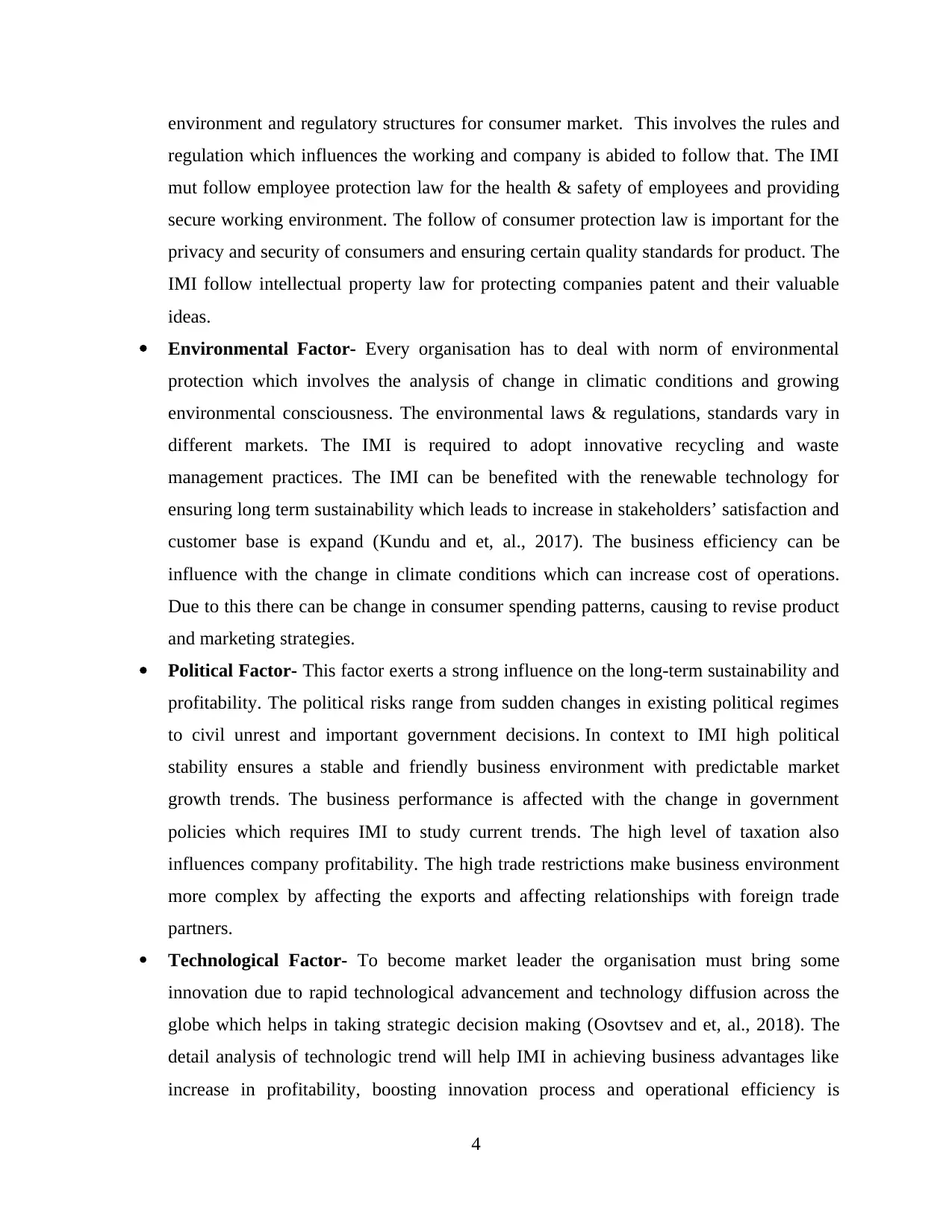
environment and regulatory structures for consumer market. This involves the rules and
regulation which influences the working and company is abided to follow that. The IMI
mut follow employee protection law for the health & safety of employees and providing
secure working environment. The follow of consumer protection law is important for the
privacy and security of consumers and ensuring certain quality standards for product. The
IMI follow intellectual property law for protecting companies patent and their valuable
ideas.
Environmental Factor- Every organisation has to deal with norm of environmental
protection which involves the analysis of change in climatic conditions and growing
environmental consciousness. The environmental laws & regulations, standards vary in
different markets. The IMI is required to adopt innovative recycling and waste
management practices. The IMI can be benefited with the renewable technology for
ensuring long term sustainability which leads to increase in stakeholders’ satisfaction and
customer base is expand (Kundu and et, al., 2017). The business efficiency can be
influence with the change in climate conditions which can increase cost of operations.
Due to this there can be change in consumer spending patterns, causing to revise product
and marketing strategies.
Political Factor- This factor exerts a strong influence on the long-term sustainability and
profitability. The political risks range from sudden changes in existing political regimes
to civil unrest and important government decisions. In context to IMI high political
stability ensures a stable and friendly business environment with predictable market
growth trends. The business performance is affected with the change in government
policies which requires IMI to study current trends. The high level of taxation also
influences company profitability. The high trade restrictions make business environment
more complex by affecting the exports and affecting relationships with foreign trade
partners.
Technological Factor- To become market leader the organisation must bring some
innovation due to rapid technological advancement and technology diffusion across the
globe which helps in taking strategic decision making (Osovtsev and et, al., 2018). The
detail analysis of technologic trend will help IMI in achieving business advantages like
increase in profitability, boosting innovation process and operational efficiency is
4
regulation which influences the working and company is abided to follow that. The IMI
mut follow employee protection law for the health & safety of employees and providing
secure working environment. The follow of consumer protection law is important for the
privacy and security of consumers and ensuring certain quality standards for product. The
IMI follow intellectual property law for protecting companies patent and their valuable
ideas.
Environmental Factor- Every organisation has to deal with norm of environmental
protection which involves the analysis of change in climatic conditions and growing
environmental consciousness. The environmental laws & regulations, standards vary in
different markets. The IMI is required to adopt innovative recycling and waste
management practices. The IMI can be benefited with the renewable technology for
ensuring long term sustainability which leads to increase in stakeholders’ satisfaction and
customer base is expand (Kundu and et, al., 2017). The business efficiency can be
influence with the change in climate conditions which can increase cost of operations.
Due to this there can be change in consumer spending patterns, causing to revise product
and marketing strategies.
Political Factor- This factor exerts a strong influence on the long-term sustainability and
profitability. The political risks range from sudden changes in existing political regimes
to civil unrest and important government decisions. In context to IMI high political
stability ensures a stable and friendly business environment with predictable market
growth trends. The business performance is affected with the change in government
policies which requires IMI to study current trends. The high level of taxation also
influences company profitability. The high trade restrictions make business environment
more complex by affecting the exports and affecting relationships with foreign trade
partners.
Technological Factor- To become market leader the organisation must bring some
innovation due to rapid technological advancement and technology diffusion across the
globe which helps in taking strategic decision making (Osovtsev and et, al., 2018). The
detail analysis of technologic trend will help IMI in achieving business advantages like
increase in profitability, boosting innovation process and operational efficiency is
4
⊘ This is a preview!⊘
Do you want full access?
Subscribe today to unlock all pages.

Trusted by 1+ million students worldwide
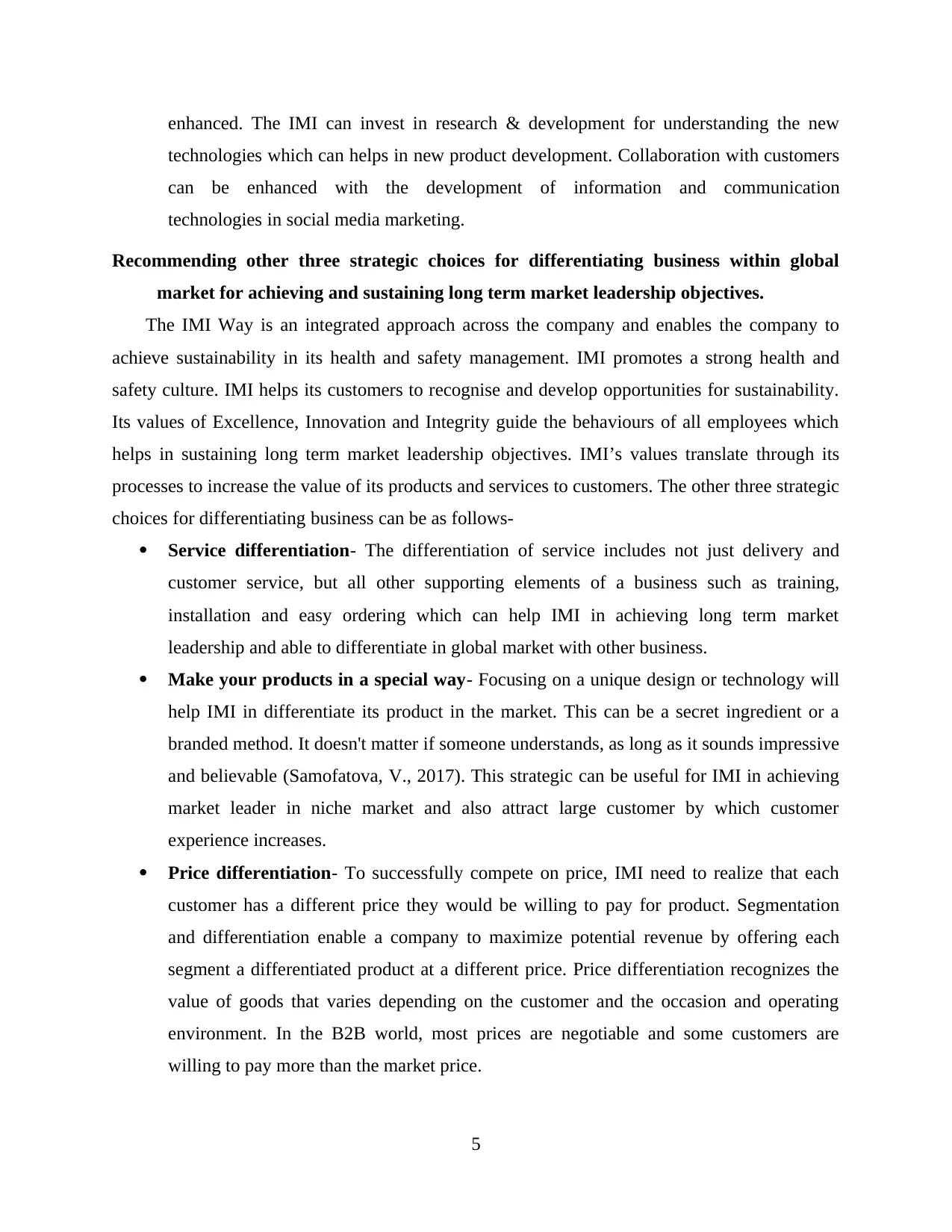
enhanced. The IMI can invest in research & development for understanding the new
technologies which can helps in new product development. Collaboration with customers
can be enhanced with the development of information and communication
technologies in social media marketing.
Recommending other three strategic choices for differentiating business within global
market for achieving and sustaining long term market leadership objectives.
The IMI Way is an integrated approach across the company and enables the company to
achieve sustainability in its health and safety management. IMI promotes a strong health and
safety culture. IMI helps its customers to recognise and develop opportunities for sustainability.
Its values of Excellence, Innovation and Integrity guide the behaviours of all employees which
helps in sustaining long term market leadership objectives. IMI’s values translate through its
processes to increase the value of its products and services to customers. The other three strategic
choices for differentiating business can be as follows-
Service differentiation- The differentiation of service includes not just delivery and
customer service, but all other supporting elements of a business such as training,
installation and easy ordering which can help IMI in achieving long term market
leadership and able to differentiate in global market with other business.
Make your products in a special way- Focusing on a unique design or technology will
help IMI in differentiate its product in the market. This can be a secret ingredient or a
branded method. It doesn't matter if someone understands, as long as it sounds impressive
and believable (Samofatova, V., 2017). This strategic can be useful for IMI in achieving
market leader in niche market and also attract large customer by which customer
experience increases.
Price differentiation- To successfully compete on price, IMI need to realize that each
customer has a different price they would be willing to pay for product. Segmentation
and differentiation enable a company to maximize potential revenue by offering each
segment a differentiated product at a different price. Price differentiation recognizes the
value of goods that varies depending on the customer and the occasion and operating
environment. In the B2B world, most prices are negotiable and some customers are
willing to pay more than the market price.
5
technologies which can helps in new product development. Collaboration with customers
can be enhanced with the development of information and communication
technologies in social media marketing.
Recommending other three strategic choices for differentiating business within global
market for achieving and sustaining long term market leadership objectives.
The IMI Way is an integrated approach across the company and enables the company to
achieve sustainability in its health and safety management. IMI promotes a strong health and
safety culture. IMI helps its customers to recognise and develop opportunities for sustainability.
Its values of Excellence, Innovation and Integrity guide the behaviours of all employees which
helps in sustaining long term market leadership objectives. IMI’s values translate through its
processes to increase the value of its products and services to customers. The other three strategic
choices for differentiating business can be as follows-
Service differentiation- The differentiation of service includes not just delivery and
customer service, but all other supporting elements of a business such as training,
installation and easy ordering which can help IMI in achieving long term market
leadership and able to differentiate in global market with other business.
Make your products in a special way- Focusing on a unique design or technology will
help IMI in differentiate its product in the market. This can be a secret ingredient or a
branded method. It doesn't matter if someone understands, as long as it sounds impressive
and believable (Samofatova, V., 2017). This strategic can be useful for IMI in achieving
market leader in niche market and also attract large customer by which customer
experience increases.
Price differentiation- To successfully compete on price, IMI need to realize that each
customer has a different price they would be willing to pay for product. Segmentation
and differentiation enable a company to maximize potential revenue by offering each
segment a differentiated product at a different price. Price differentiation recognizes the
value of goods that varies depending on the customer and the occasion and operating
environment. In the B2B world, most prices are negotiable and some customers are
willing to pay more than the market price.
5
Paraphrase This Document
Need a fresh take? Get an instant paraphrase of this document with our AI Paraphraser
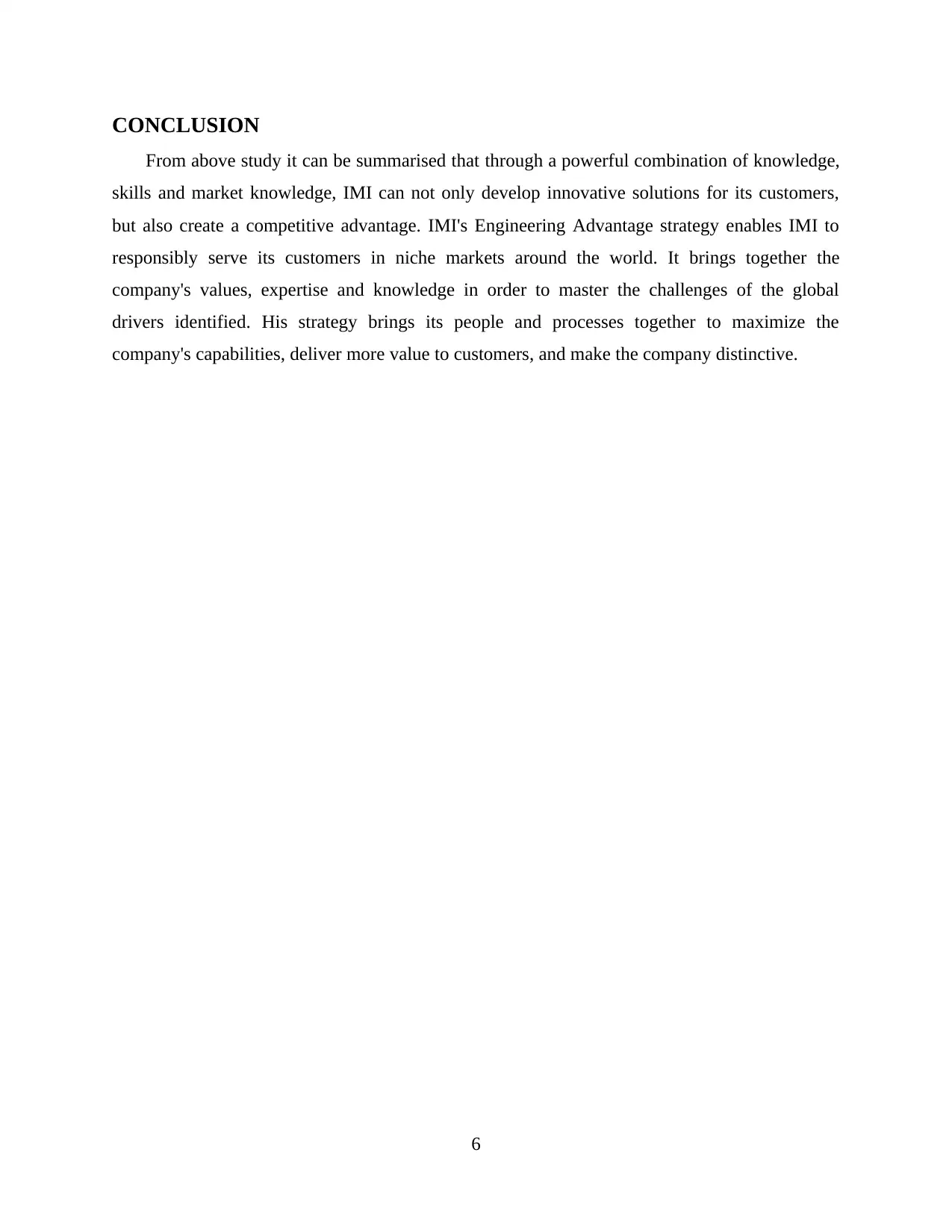
CONCLUSION
From above study it can be summarised that through a powerful combination of knowledge,
skills and market knowledge, IMI can not only develop innovative solutions for its customers,
but also create a competitive advantage. IMI's Engineering Advantage strategy enables IMI to
responsibly serve its customers in niche markets around the world. It brings together the
company's values, expertise and knowledge in order to master the challenges of the global
drivers identified. His strategy brings its people and processes together to maximize the
company's capabilities, deliver more value to customers, and make the company distinctive.
6
From above study it can be summarised that through a powerful combination of knowledge,
skills and market knowledge, IMI can not only develop innovative solutions for its customers,
but also create a competitive advantage. IMI's Engineering Advantage strategy enables IMI to
responsibly serve its customers in niche markets around the world. It brings together the
company's values, expertise and knowledge in order to master the challenges of the global
drivers identified. His strategy brings its people and processes together to maximize the
company's capabilities, deliver more value to customers, and make the company distinctive.
6
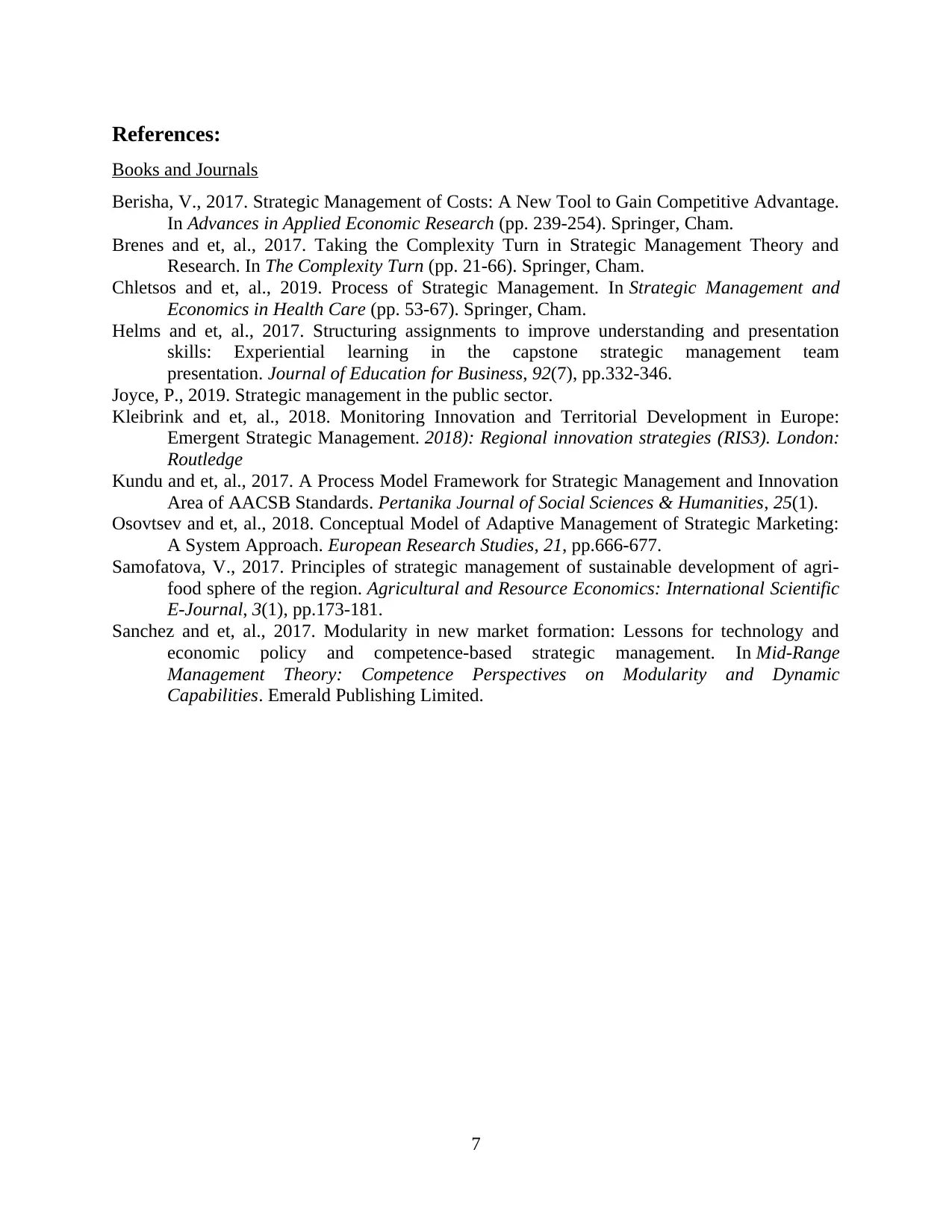
References:
Books and Journals
Berisha, V., 2017. Strategic Management of Costs: A New Tool to Gain Competitive Advantage.
In Advances in Applied Economic Research (pp. 239-254). Springer, Cham.
Brenes and et, al., 2017. Taking the Complexity Turn in Strategic Management Theory and
Research. In The Complexity Turn (pp. 21-66). Springer, Cham.
Chletsos and et, al., 2019. Process of Strategic Management. In Strategic Management and
Economics in Health Care (pp. 53-67). Springer, Cham.
Helms and et, al., 2017. Structuring assignments to improve understanding and presentation
skills: Experiential learning in the capstone strategic management team
presentation. Journal of Education for Business, 92(7), pp.332-346.
Joyce, P., 2019. Strategic management in the public sector.
Kleibrink and et, al., 2018. Monitoring Innovation and Territorial Development in Europe:
Emergent Strategic Management. 2018): Regional innovation strategies (RIS3). London:
Routledge
Kundu and et, al., 2017. A Process Model Framework for Strategic Management and Innovation
Area of AACSB Standards. Pertanika Journal of Social Sciences & Humanities, 25(1).
Osovtsev and et, al., 2018. Conceptual Model of Adaptive Management of Strategic Marketing:
A System Approach. European Research Studies, 21, pp.666-677.
Samofatova, V., 2017. Principles of strategic management of sustainable development of agri-
food sphere of the region. Agricultural and Resource Economics: International Scientific
E-Journal, 3(1), pp.173-181.
Sanchez and et, al., 2017. Modularity in new market formation: Lessons for technology and
economic policy and competence-based strategic management. In Mid-Range
Management Theory: Competence Perspectives on Modularity and Dynamic
Capabilities. Emerald Publishing Limited.
7
Books and Journals
Berisha, V., 2017. Strategic Management of Costs: A New Tool to Gain Competitive Advantage.
In Advances in Applied Economic Research (pp. 239-254). Springer, Cham.
Brenes and et, al., 2017. Taking the Complexity Turn in Strategic Management Theory and
Research. In The Complexity Turn (pp. 21-66). Springer, Cham.
Chletsos and et, al., 2019. Process of Strategic Management. In Strategic Management and
Economics in Health Care (pp. 53-67). Springer, Cham.
Helms and et, al., 2017. Structuring assignments to improve understanding and presentation
skills: Experiential learning in the capstone strategic management team
presentation. Journal of Education for Business, 92(7), pp.332-346.
Joyce, P., 2019. Strategic management in the public sector.
Kleibrink and et, al., 2018. Monitoring Innovation and Territorial Development in Europe:
Emergent Strategic Management. 2018): Regional innovation strategies (RIS3). London:
Routledge
Kundu and et, al., 2017. A Process Model Framework for Strategic Management and Innovation
Area of AACSB Standards. Pertanika Journal of Social Sciences & Humanities, 25(1).
Osovtsev and et, al., 2018. Conceptual Model of Adaptive Management of Strategic Marketing:
A System Approach. European Research Studies, 21, pp.666-677.
Samofatova, V., 2017. Principles of strategic management of sustainable development of agri-
food sphere of the region. Agricultural and Resource Economics: International Scientific
E-Journal, 3(1), pp.173-181.
Sanchez and et, al., 2017. Modularity in new market formation: Lessons for technology and
economic policy and competence-based strategic management. In Mid-Range
Management Theory: Competence Perspectives on Modularity and Dynamic
Capabilities. Emerald Publishing Limited.
7
⊘ This is a preview!⊘
Do you want full access?
Subscribe today to unlock all pages.

Trusted by 1+ million students worldwide
1 out of 9
Related Documents
Your All-in-One AI-Powered Toolkit for Academic Success.
+13062052269
info@desklib.com
Available 24*7 on WhatsApp / Email
![[object Object]](/_next/static/media/star-bottom.7253800d.svg)
Unlock your academic potential
Copyright © 2020–2025 A2Z Services. All Rights Reserved. Developed and managed by ZUCOL.




